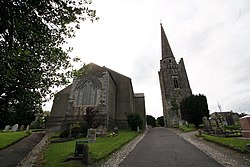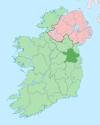Kells, County Meath
This article needs additional citations for verification. (September 2016) |
Kells
Ceanannas | |
|---|---|
Town | |
 St Columba's Church of Ireland, Kells | |
 Kells Location in Ireland | |
| Coordinates: 53°43′38″N 6°52′37″W / 53.7272°N 6.8769°WCoordinates: 53°43′38″N 6°52′37″W / 53.7272°N 6.8769°W | |
| Country | Ireland |
| Province | Leinster |
| County | County Meath |
| Area | |
| • Total | 2.8 km2 (1.1 sq mi) |
| Elevation | 66 m (217 ft) |
| Population (2016)[1] | |
| • Total | 6,135 |
| • Density | 2,200/km2 (5,700/sq mi) |
| Eircode routing key | A82 |
| Telephone area code | +353(0)46 |
| Irish Grid Reference | N738759 |
Kells (/ˈkɛlz/; Irish: Ceanannas)[2] is a town in County Meath, Ireland. The town lies off the M3 motorway, 16 km (10 mi) from Navan and 65 km (40 mi) from Dublin. It is best known as the site of Kells Abbey, from which the Book of Kells takes its name.
Name[]
The settlement was originally known by the Irish name Ceannanas or Ceannanus, and it is suggested that the name 'Kells' developed from this.[3] From the 12th century onward, the settlement was referred to in English and Anglo-Norman as Kenenus, Kenelles, Kenles, Kenlis, Kellis and finally Kells.[3] It has also been suggested that Kenlis and Kells come from an alternative Irish name, Ceann Lios, meaning "[the] head fort". Kells, Kenlis and Headfort all feature in the titles taken by the Taylor family.
In 1929, Ceannanus Mór was made the town's official name in both Irish and English.[3] Following the creation of the Irish Free State, a number of towns were renamed likewise. Ceanannas has been the official Irish-language form of the place name since 1969.[4] In 1993, Kells was re-adopted as the town's official name in English.[5]
History[]

Before Kells was a monastery, it was the site of a royal site inhabited by the High King Cormac mac Airt who moved his residence from the Hill of Tara,[citation needed] for reasons scholars are not yet sure about.
Kells was an important place on one of the five ancient roads that came out of Tara - this road being named Slí nan nAssail and which ran from Tara to Rathcrogan, another royal site, in County Roscommon.[citation needed]
About 560 AD, Colmcille (later known as Columba) – a prince of the royal house of the Northern Uí Néill family – acquired Kells in recompense of a fault acted against him by his cousin the High King Diarmuid MacCarroll, who granted him the Dún of Ceannanus to establish a Monastery.[citation needed]
The present monastery at Kells is thought to have been founded around 804 AD by monks from St Colmcille's monastery in Iona who were fleeing Viking invasions.[citation needed]
In 1152, the Synod of Kells completed the transition of the Colmcille's establishment from a monastic church to a diocesan church.[citation needed] A later synod reduced the status of Kells to that of a parish. Following the Norman invasion of Ireland, Hugh de Lacy was granted the Lordship of Meath in 1182. The religious establishments at Kells continued to flourish under their Anglo-Norman overlords.
Kells became a border town garrison of the Pale and was the scene of many battles between the Kingdom of Breifne and the Hiberno-Normans (who had heavily intermarried).[citation needed] From 1561 to 1800, Kells returned two MPs to the Parliament of Ireland.[citation needed] During the Irish rebellion of 1641, Kells was burned by the O'Reilly clan during their attacks on the Pale.[citation needed]
The period of the Great Famine saw the population of Kells drop by 38% as measured by the census records of 1841 and 1851.[citation needed] The Workhouse and the Fever Hospital were described as full to overflowing.[citation needed]
Places of interest[]
The Kells Monastic Site, with its round tower, is associated with St Colmcille (also known as Columba), the Book of Kells, now kept at Trinity College Dublin and the Kells Crozier, exhibited at the British Museum. The round tower and five large Celtic crosses can still be viewed today. Four of the crosses are in the churchyard of St Columba's church. The other Celtic cross was positioned in the middle of a busy crossroads until an accident involving a school bus. It now stands in front of a former courthouse. A roof protects the cross from the elements. A replica also stands safe from the elements inside the museum.[citation needed]

Close by the graveyard of St. Columba's church stands a small stone roofed Oratory (St. Colmcille's House). This probably dates from the 11th century. Access to the monks' sleeping accommodation aloft is by ladder. This small rectangular building is positioned at one of the highest points in the town. The Oratory is kept locked, but visitor access can be arranged.
Just outside the town of Kells on the road to Oldcastle is the hill of Lloyd, named after Thomas Lloyd of Enniskillen, who camped a large Williamite army here during the wars of 1688-91 against the Jacobites. Here also stands a 30m high building called the Spire of Lloyd, which is an 18th-century lighthouse folly, the area around the tower has been developed as a community park (The People's Park), and includes the Paupers' Grave. This cemetery was a necessity in the times of great poverty in the country. Mass is still celebrated there annually and the cemetery is a reminder of the Workhouse and extreme poverty engendered by changes in farming practice in the 19th century and during the Famine.
Population[]
The population of Kells town (according to the official 2016 Census of Population) was 6,135. This represented a slight increase in population over the 2011 Census.[1] There was a 22% increase in total population between 1996 and 2002.
Transport[]
Roads[]
Until the opening of the new motorway in June 2010, Kells stood as a busy junction town on the old N3 road with over 18,000 vehicles passing through the town each day. Kells was a renowned traffic bottleneck from both the N3 national primary route (Dublin, Cavan, Enniskillen and Ballyshannon) and N52 national secondary route (Dundalk, Tullamore and Nenagh) passing through the town centre. The new M3 motorway (opened June 2010) significantly reduces the journey time to Dublin, as well as the numbers of vehicles in the town.
Bus[]
Kells is served by a regular bus service run by Bus Éireann, the 109, 109A and 109X, which takes about 1.5 hours to Busáras in Dublin.
Railway[]
The original Kells railway station, serving a line between Oldcastle and Drogheda via Navan, opened on 11 July 1853. It was closed for passenger traffic on 14 April 1958 and finally for all traffic on 1 April 1963.[6]
"Meath on Track" are seeking reinstatement of the Navan railway link, and on to Dublin. It is estimated that a Kells to Dublin City Centre rail service would take approximately 60 minutes depending on stops.
Film[]
The Butcher Boy was filmed at Headfort House. Other films set in Kells include the Oscar-nominated animated film The Secret of Kells.
The Hollywood actor Maureen O'Hara was a native of Kells. Her father Charles came from the town, although Maureen grew up in Dublin. Charles was born in a house at the bottom of Farrell Street in the town, a building that now houses a supermarket, carpet shop and apartments. She visited the town on 26 May 2012 to receive the freedom of the town and to unveil a bust in her honour.[citation needed]
Events[]
Since 2014, Kells has been home to the documentary film festival, the International Documentary Film Festival.[7]
Hay Festival Kells was home to Ireland's only Hay Festival,[clarification needed] which then transmuted into the current Hinterlands festival.[citation needed]
Education[]
St. Ciarans Community School Kells, Navan Road, Kells is a mixed secondary school in Kells which first opened in September 1988 and has around 640 students in attendance. It was first formed by the amalgamation of the Christian Brothers Secondary School and Kells Vocational School.[8]
Eureka secondary school Kells, Navan Road, Kells was first opened by Sisters of Mercy secondary education for girls in Kells in classrooms attached to the Convent in 1924. The school moved to the existing site at Eureka House in 1956[9] and is planning a move once again to the cavan road site in 2018.
St. Colmcilles Boys National school is an all boys school on the Navan road, first opened by the Christian Brothers on 20 January 1845. The present school was opened in 1976 and the Brothers, because of a fall-off in vocations, withdrew from the school in 1985.[10]
Music[]
- Jim Connell of Crossakiel b. 1852, Kells wrote the Socialist anthem "The Red Flag"
- Dick Farrelly, songwriter known for his song, The "Isle of Innisfree", 1952 hit for Bing Crosby and theme of the film, "The Quiet Man".
- Irish indie rock bands Ham Sandwich and Turn are associated with Kells.[citation needed]
- Mícheál Ó Domhnaill, singer, guitarist, composer, and producer. Member of The Bothy Band, Relativity, and Nightnoise.
- Eamon Carr (born 12 November 1948), is from Kells, County Meath. He was one of the founding members of a poetry and beat performance group called Tara Telephone in Dublin in the late 1960s that also published the quarterly literary journal Capella. He is the drummer in the band Horslips.[citation needed]
Notable people[]
- Thomas Betagh (1737-1811), Jesuit priest and educationist was born and bred in Kells.
- Damien McGrane (b. 1971), professional golfer is a Kells man.
- Denis Hurley, rugby player, was born and bred in Kells.
- Myles Dungan, broadcaster, historian and journalist is from Kells.
- Xabi Alonso, Spanish World cup winning footballer spent time here learning English in a school exchange programme when he was a teenager[11]
- Ray Butler, Fine Gael politician
See also[]
- Kells, County Kilkenny
- Kells, County Antrim
- List of towns and villages in Ireland
- Market Houses in Ireland
- North Meath RFC
References[]
- ^ Jump up to: a b c "Population Density and Area Size 2016". Central Statistics Office (Ireland). Retrieved 24 March 2019.
- ^ For most of the 20th century the town's official name was Ceanannas Mór. In the late 20th century the town reverted to the more widely known English version of its name, Kells, and dropped Mór from the Irish version of the name.
- ^ Jump up to: a b c Placenames Database of Ireland (see archival records)
- ^ Logainm placenames database of Ireland (in Irish)
- ^ S.I. No. 156/1993 - Local Government (Change of Name of Urban District) Order, 1993. Irish Statute Book.
- ^ "Kells station" (PDF). Railscot - Irish Railways. Retrieved 16 October 2007.
- ^ http://guthgafa.com/[bare URL]
- ^ http://www.flocms.ie, Content Management System FLO CMS V3. "History | Facilities | St Ciarans Community School". www.stciaranscs.ie. Retrieved 31 March 2017.
- ^ "History of Eureka". Eureka Secondary School. Retrieved 31 March 2017.
- ^ "St. Colmcilles School, Kells, Meath". St. Colmcilles School, Kells, Meath. Retrieved 31 March 2017.
- ^ "Kells recalls the summer a future World Cup winner came to stay". meathchronicle.ie. 15 July 2010.
External links[]
| Wikivoyage has a travel guide for Kells. |
| Wikimedia Commons has media related to Kells, County Meath. |
| Wikisource has the text of the Encyclopædia Britannica (9th ed.) article Kells. |
- Kellsonline.ie, News & Event Guide to Kells
- VisitingKells, Tourist Information on Kells
- Kells, County Meath
- Towns and villages in County Meath

